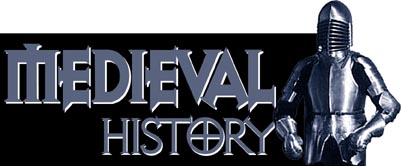
|


|
|
|
Mr. Sedivy's
More Features:
|
Highlands Ranch High School - Mr. Sedivy -
The Middle Ages - Hundred Years War (1337 - 1453) The Hundred Years War was in the middle of another very stupid war. It was a series of wars between England and France, and all fighting occurred in France.
Beginning of the Hundred Years War Edward's father, Edward II was a wormy little wimp; Edward III was manly, handsome and chivalrous, also a great warrior and good king. He became king at the age of 14 due to the scheming of his mother, Isabella and her lover, Mortimer. When Edward turned 17, he threw them off completely - Mortimer was tried before Parliament for a long list of crimes and was executed, and Isabella was obliged to retire to a castle in Norfolk. Also, under Edward III tournaments became big, especially jousting. Edward III was worried about how French kings had been taking English land in France for a long time. First Phase of the Hundred Years War Edward the Black Prince captured Bordeaux in 1355. During September 1356, England won at Poiters (in south-central France) under Edward the Black Prince. The English had invented the long bow, and this gave them an advantage. They easily could, from long range, knock the French off their horses, plus the French had a hard time moving around in their heavy armor. Treaty gave England control of large parts of France. France renewed the war in 1364 under Charles V. France turned the tide by not directly engaging the English. The death of the Black Prince in 1376, and the death of Edward III in 1377 weakened the English. (Edward III was succeeded by the 9-year-old, Richard II.) England had been weakened due to internal struggling, primarily over taxes. France regained most of the lost land. Final Battles of the Hundred Years War
Joan of Arc Joan of Arc persuaded the French dauphin to let her lead. He didn't want to let this tiny woman lead the French troops, but she convinced him. She left the farm where she worked at age 17. At first, she had to dress like a man so the troops wouldn't know her true identity.
Joan of Arc believed God had commanded her to drive the English from France. She led the French to victory at Orleans, the turning point of the war, and Joan of Arc pushed the English north. Superstitious English soldiers were afraid when she rode up carrying an ancient sword (used by Charles the Hammer at the Battle of Tours).
Joan of Arc was captured by opponents of the French king and turned over to the English King Henry VI, who burned her at the stake for being a witch. She set an example that inspired the French. France drove England from France (except for Calais) and the power of the French Monarchy prevailed. The dauphin became King Charles VII, the victorious. The fighting ended in 1453, but no formal treaty was ever signed. In 1920, the Pope made her a saint. Decline of the Medieval Church 1. Early Middle Ages: Dark Ages and Feudalism 2. Clovis, Charles the Hammer,
Charlemagne, 3. The Roman Catholic Church in the Middle Ages 4. High Middle Ages / National Monarchies 6. Knights, Heraldry, and Medieval Warfare 8th-
to 15th-Century Poems
and Prose More
Information Mr.
Sedivy's Tour of Medieval Rothenburg Medieval Penalties
of Shame and Honor - Historical Periods of | Prehistory
| Mesopotamia & Phoenicians |
|
Highlands Ranch High School ![]() 9375 South Cresthill Lane
9375 South Cresthill Lane ![]() Highlands Ranch, Colorado 80126
Highlands Ranch, Colorado 80126 ![]() 303-471-7000
303-471-7000
Mr. Sedivy's History Classes
| Colorado History | American
Government | Modern European History | Advanced
Placement European History | Rise of England
| World History |
| Home | Back to Top of Page |
Site Contents |





